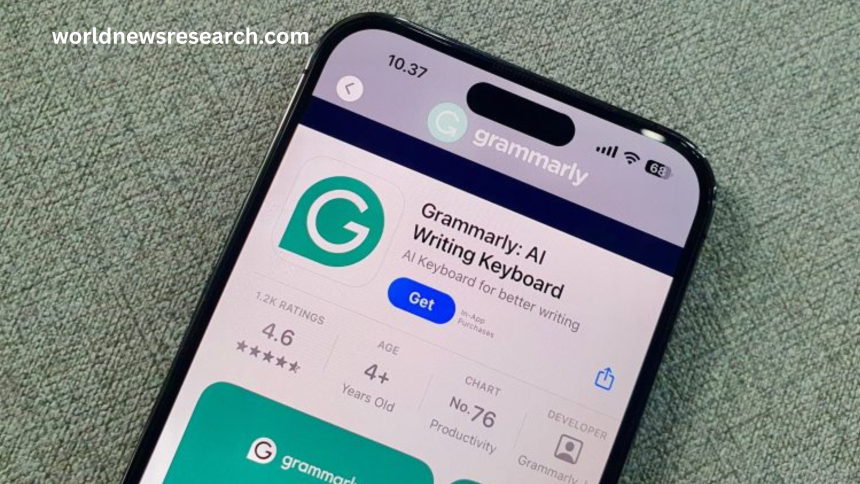Grammarly, the AI-powered writing assistant trusted by users across the globe, has secured a landmark nondilutive funding round from General Catalyst. This massive infusion of capital marks a significant milestone in Grammarly’s evolution and represents a broader trend in the technology and artificial intelligence landscape. The move is not only a vote of confidence in Grammarly’s mission and performance but also signals an emerging model of funding that allows companies to scale while maintaining control.
In this article, we will explore Grammarly’s journey, the mechanics of nondilutive funding, the strategic role of General Catalyst, and the broader implications this deal has on the AI industry and the future of digital communication.
Grammarly: Revolutionizing Modern Communication
Grammarly began as a grammar-checking tool designed to help people improve their written English. Over time, it transformed into an advanced AI-powered assistant that improves clarity, tone, coherence, and effectiveness across different types of writing. From informal chats and school essays to business emails and marketing campaigns, Grammarly is helping individuals and organizations communicate with greater impact.
Today, Grammarly has embedded itself into the daily workflow of professionals, students, and institutions. It integrates seamlessly with various platforms like email clients, word processors, browsers, and messaging apps, making it a ubiquitous presence in the world of digital writing.
The company’s mission is to improve lives by improving communication. With a powerful combination of natural language processing, deep learning, and continuous AI training, Grammarly analyzes context, tone, and intent to suggest meaningful edits beyond basic grammar corrections.
Unpacking the Nondilutive Funding Deal
What Is Nondilutive Capital?
Nondilutive capital refers to funding that does not require the recipient to give up ownership or shares in the company. This stands in contrast to traditional equity financing, where investors receive a portion of ownership in exchange for capital. Nondilutive funding can come in several forms, such as loans, grants, or revenue-sharing agreements.
In Grammarly’s case, this form of capital allows the company to raise substantial financial resources while preserving full control and ownership among existing shareholders. It is especially appealing for companies with strong revenue streams, steady cash flow, and long-term vision.
Strategic Benefits for Grammarly
By choosing nondilutive capital, Grammarly gains access to substantial funds without giving up equity or diluting its stakeholder base. This approach offers multiple strategic advantages:
- It allows Grammarly to maintain decision-making autonomy.
- It ensures that founders, early employees, and investors keep their stakes intact.
- It enables Grammarly to continue operating with a long-term vision, free from the pressures of immediate return expectations often associated with equity investors.
About General Catalyst
General Catalyst is a prominent venture capital firm known for backing technology companies that create real impact. With a portfolio that includes several of the most recognized names in the tech industry, General Catalyst focuses on businesses that align with its vision of responsible innovation.
Its relationship with Grammarly is built on a shared belief in technology as a force for good. By investing in Grammarly through nondilutive means, General Catalyst reaffirms its commitment to supporting companies that create meaningful, long-term value.
The firm is also a leader in promoting funding models that prioritize company health, sustainable growth, and founder-led visions. Grammarly’s deal serves as a powerful example of how such funding can work at scale.
How Grammarly Will Use the Capital
With fresh funding in hand, Grammarly is poised to accelerate its efforts across several dimensions. The capital will not be used just for expansion, but also for creating an intelligent and inclusive communication platform for the future.
Driving Innovation in AI
One of Grammarly’s top priorities will be to enhance its AI capabilities. The company plans to invest in generative models, real-time conversation aids, and adaptive writing tools that learn and evolve with user behavior.
Future innovations could include tools for voice and video communication, AI-powered storytelling, and advanced emotional intelligence in written dialogue. The funding will enable Grammarly to build the next generation of communication products powered by cutting-edge AI.
Strengthening the Enterprise Segment
Grammarly for Business has grown significantly, providing teams with scalable tools for professional communication. With the new capital, Grammarly intends to deepen its offerings for large organizations by developing features like role-specific writing assistance, team collaboration analytics, and integration with enterprise software ecosystems.
This focus will allow Grammarly to become a cornerstone of professional writing within corporations, government organizations, and educational institutions.
Expanding Global Presence
Although Grammarly is widely known in English-speaking countries, there remains significant room for growth in international markets. Localization, multilingual support, and regional tone adjustments will be key areas of focus.
By tailoring its products to various linguistic and cultural contexts, Grammarly can broaden its reach and become a global communication standard.
Strategic Partnerships and Acquisitions
With additional resources, Grammarly will have the flexibility to pursue partnerships and acquisitions that align with its vision. This could include acquiring startups in adjacent technology spaces, such as voice technology, education platforms, or cross-lingual communication services.
These moves will allow Grammarly to build a comprehensive suite of tools that address the evolving needs of its diverse user base.
Grammarly’s Role in the Future of Communication
Communication has always been central to human interaction. In the digital era, where text-based interaction dominates, tools that enhance communication are essential.
Grammarly has become more than a grammar checker. It is a writing partner that helps users express themselves clearly, professionally, and confidently. Its AI-powered engine analyzes intent, tone, and structure to offer meaningful suggestions that go beyond surface-level corrections.
As the demand for personalized, context-aware communication continues to grow, Grammarly is positioned to lead the way. The platform’s ability to adapt to a user’s writing style and goals is particularly valuable in an age where authenticity and nuance are critical.
Industry Context and Competitive Landscape
The AI-powered communication space has seen an influx of players, each with different strengths. Grammarly’s competitors range from generative AI platforms focused on marketing copy to large tech companies integrating AI into productivity suites.
However, Grammarly has carved a unique niche by focusing on communication quality, ethical AI development, and user trust. Its freemium model ensures accessibility, while its premium tiers offer advanced features for professionals and businesses.
To stay ahead, Grammarly must continue evolving and investing in areas like voice communication, real-time collaboration, and multilingual assistance. The fresh funding gives it the fuel to stay competitive in a crowded and rapidly changing landscape.
Challenges Ahead
Despite its success, Grammarly faces several challenges that could impact its trajectory:
Ethical and Regulatory Issues
AI technologies that influence communication are subject to scrutiny. Grammarly must maintain high standards in privacy, data security, and fairness to uphold its reputation. As AI regulations evolve globally, compliance will become increasingly complex and critical.
Technological Dependence
While Grammarly leverages both proprietary models and external AI infrastructure, it must be careful not to become overly dependent on third-party providers. Investing in its own models and infrastructure will ensure long-term sustainability and independence.
Balancing Monetization and Accessibility
Grammarly’s widespread adoption is largely due to its free tier. As the company expands its premium offerings and enterprise tools, it must balance growth with accessibility to retain its broad user base and brand goodwill.
Cultural Influence and Social Responsibility
Grammarly’s influence extends beyond product features. It plays a role in shaping modern communication norms, particularly around professionalism, tone sensitivity, and linguistic inclusivity. With this power comes responsibility.
The company must ensure its tools do not inadvertently reinforce biases or cultural homogenization. Embracing linguistic diversity and respecting different communication styles will be vital for Grammarly’s social credibility and global appeal.
As it expands, Grammarly has the opportunity to lead by example—promoting ethical AI practices and advocating for inclusive communication standards that serve everyone.
Investor Confidence and Industry Significance
Grammarly’s nondilutive funding from General Catalyst is more than just a financial milestone. It reflects growing investor confidence in companies that combine AI innovation with ethical business practices and sustainable models.
This funding structure may inspire other tech companies to explore nondilutive options as they scale. In doing so, it challenges the conventional venture capital paradigm and opens new pathways for founders to build independent, values-driven businesses.
The Grammarly deal also underscores the value investors see in applied AI solutions that serve clear human needs. Rather than abstract technologies, Grammarly delivers practical tools that millions use daily to communicate more effectively. That combination of utility, scale, and integrity is exactly what long-term investors are looking for.
Looking Ahead: Grammarly’s Future
The path forward for Grammarly is filled with promise. With deep pockets, a trusted investor, and a clear mission, the company is in a strong position to shape the future of AI-assisted communication.
In the coming years, Grammarly could evolve from a text-based assistant into a full-spectrum communication platform. Whether it’s helping users write better emails, give better presentations, or communicate across languages and media, Grammarly is aiming to be present wherever people need to express ideas clearly.
Ultimately, the company’s success will depend not only on its technology but on its ability to understand and serve the evolving needs of a global, multilingual, and digitally connected population.
Frequently Asked Questions
Why did Grammarly choose this type of funding?
Grammarly opted for nondilutive funding to raise significant capital without sacrificing ownership or control. This supports its long-term goals without the pressure of external equity investors
Who provided the funding to Grammarly?
The funding came from General Catalyst, a well-known investment firm that supports mission-driven technology companies.
How will Grammarly use the funding?
Grammarly plans to use the capital to:
- Advance its artificial intelligence capabilities
- Expand services for business users
- Grow internationally
- Pursue partnerships and acquisitions
- Improve user experience across platforms
Will Grammarly’s services change for users?
No major changes are expected for users right away. However, the funding will support improvements in features, user experience, and new tools over time.
Does this mean Grammarly is planning to go public?
There has been no official announcement about Grammarly becoming a public company. The funding supports continued growth and could provide flexibility for future strategic decisions.
What sets Grammarly apart in the writing technology space?
Grammarly is more than a grammar checker. It helps users improve clarity, tone, and intent in their writing, acting as a real-time communication assistant across different platforms.
Is this type of funding common in the tech world?
Nondilutive funding is less common than equity investment but is growing in popularity among mature tech companies that generate consistent revenue and want to retain ownership.
What’s in it for General Catalyst?
General Catalyst benefits by aligning with a high-performing company while supporting a funding model focused on ethical growth, long-term impact, and innovation.
Will Grammarly expand into more languages?
While Grammarly is currently focused on English, the new funding could support efforts to add multilingual features and expand its global reach.
How does this affect the broader AI writing industry?
This deal shows investor confidence in applied AI that solves everyday problems. It also suggests that alternative funding models can help companies grow responsibly.
What can users expect from Grammarly in the future?
Users may see smarter suggestions, better collaboration tools, enhanced tone detection, and possibly new services involving voice or video communication.
Conclusion
Grammarly’s nondilutive funding round from General Catalyst is a transformative event in the tech industry. It reflects a growing maturity in the AI sector and a desire among leading investors to support innovation without compromising founder control.






